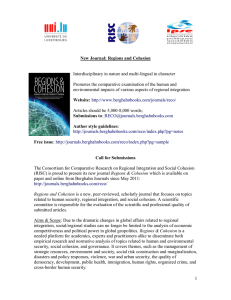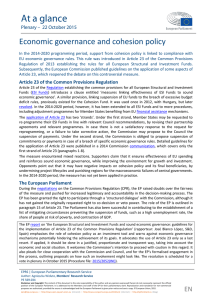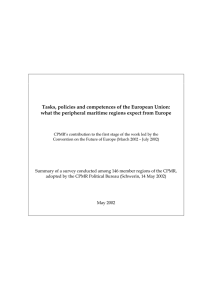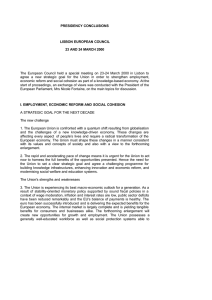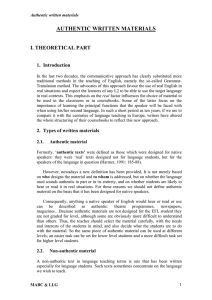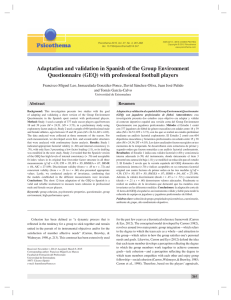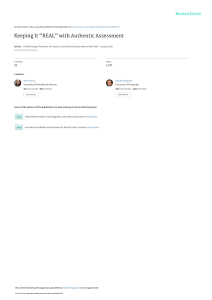Authentic leadership, group cohesion and group
Anuncio
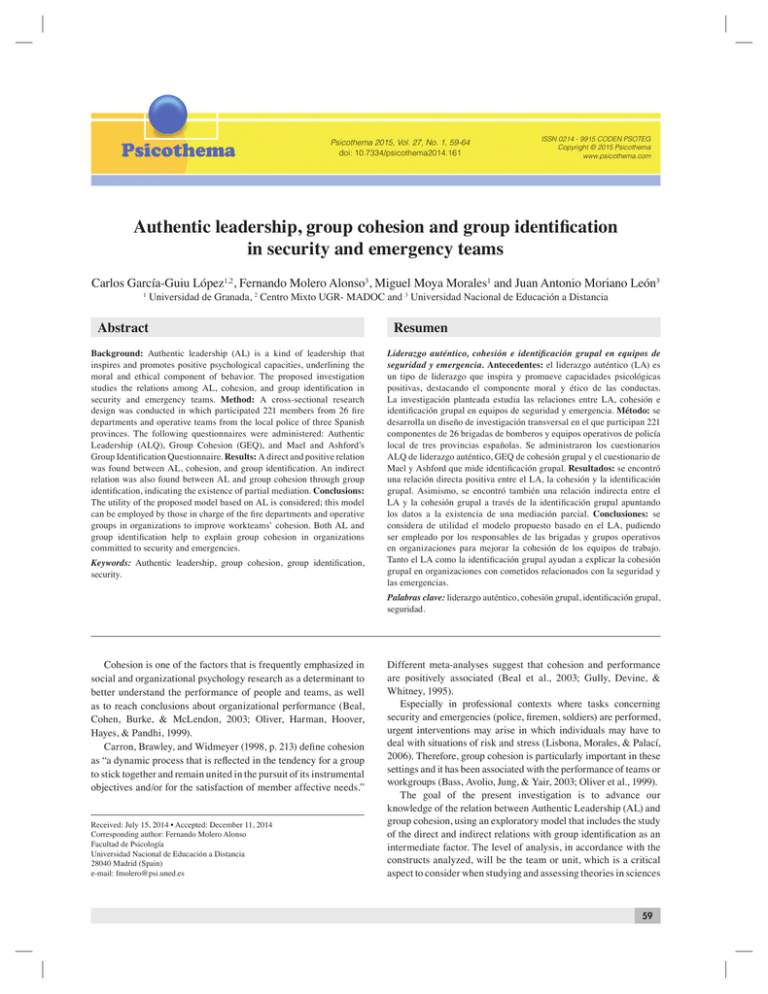
Psicothema 2015, Vol. 27, No. 1, 59-64 doi: 10.7334/psicothema2014.161 ISSN 0214 - 9915 CODEN PSOTEG Copyright © 2015 Psicothema www.psicothema.com Authentic leadership, group cohesion and group identification in security and emergency teams Carlos García-Guiu López1,2, Fernando Molero Alonso3, Miguel Moya Morales1 and Juan Antonio Moriano León3 1 Universidad de Granada, 2 Centro Mixto UGR- MADOC and 3 Universidad Nacional de Educación a Distancia Abstract Background: Authentic leadership (AL) is a kind of leadership that inspires and promotes positive psychological capacities, underlining the moral and ethical component of behavior. The proposed investigation studies the relations among AL, cohesion, and group identification in security and emergency teams. Method: A cross-sectional research design was conducted in which participated 221 members from 26 fire departments and operative teams from the local police of three Spanish provinces. The following questionnaires were administered: Authentic Leadership (ALQ), Group Cohesion (GEQ), and Mael and Ashford’s Group Identification Questionnaire. Results: A direct and positive relation was found between AL, cohesion, and group identification. An indirect relation was also found between AL and group cohesion through group identification, indicating the existence of partial mediation. Conclusions: The utility of the proposed model based on AL is considered; this model can be employed by those in charge of the fire departments and operative groups in organizations to improve workteams’ cohesion. Both AL and group identification help to explain group cohesion in organizations committed to security and emergencies. Keywords: Authentic leadership, group cohesion, group identification, security. Resumen Liderazgo auténtico, cohesión e identifi cación grupal en equipos de seguridad y emergencia. Antecedentes: el liderazgo auténtico (LA) es un tipo de liderazgo que inspira y promueve capacidades psicológicas positivas, destacando el componente moral y ético de las conductas. La investigación planteada estudia las relaciones entre LA, cohesión e identificación grupal en equipos de seguridad y emergencia. Método: se desarrolla un diseño de investigación transversal en el que participan 221 componentes de 26 brigadas de bomberos y equipos operativos de policía local de tres provincias españolas. Se administraron los cuestionarios ALQ de liderazgo auténtico, GEQ de cohesión grupal y el cuestionario de Mael y Ashford que mide identificación grupal. Resultados: se encontró una relación directa positiva entre el LA, la cohesión y la identificación grupal. Asimismo, se encontró también una relación indirecta entre el LA y la cohesión grupal a través de la identificación grupal apuntando los datos a la existencia de una mediación parcial. Conclusiones: se considera de utilidad el modelo propuesto basado en el LA, pudiendo ser empleado por los responsables de las brigadas y grupos operativos en organizaciones para mejorar la cohesión de los equipos de trabajo. Tanto el LA como la identificación grupal ayudan a explicar la cohesión grupal en organizaciones con cometidos relacionados con la seguridad y las emergencias. Palabras clave: liderazgo auténtico, cohesión grupal, identificación grupal, seguridad. Cohesion is one of the factors that is frequently emphasized in social and organizational psychology research as a determinant to better understand the performance of people and teams, as well as to reach conclusions about organizational performance (Beal, Cohen, Burke, & McLendon, 2003; Oliver, Harman, Hoover, Hayes, & Pandhi, 1999). Carron, Brawley, and Widmeyer (1998, p. 213) define cohesion as “a dynamic process that is reflected in the tendency for a group to stick together and remain united in the pursuit of its instrumental objectives and/or for the satisfaction of member affective needs.” Received: July 15, 2014 • Accepted: December 11, 2014 Corresponding author: Fernando Molero Alonso Facultad de Psicología Universidad Nacional de Educación a Distancia 28040 Madrid (Spain) e-mail: [email protected] Different meta-analyses suggest that cohesion and performance are positively associated (Beal et al., 2003; Gully, Devine, & Whitney, 1995). Especially in professional contexts where tasks concerning security and emergencies (police, firemen, soldiers) are performed, urgent interventions may arise in which individuals may have to deal with situations of risk and stress (Lisbona, Morales, & Palací, 2006). Therefore, group cohesion is particularly important in these settings and it has been associated with the performance of teams or workgroups (Bass, Avolio, Jung, & Yair, 2003; Oliver et al., 1999). The goal of the present investigation is to advance our knowledge of the relation between Authentic Leadership (AL) and group cohesion, using an exploratory model that includes the study of the direct and indirect relations with group identification as an intermediate factor. The level of analysis, in accordance with the constructs analyzed, will be the team or unit, which is a critical aspect to consider when studying and assessing theories in sciences 59 Carlos García-Guiu López, Fernando Molero Alonso, Miguel Moya Morales and Juan Antonio Moriano León of organization and leadership (Yammarino & Dansereau, 2011) and which is frequently not taken into account. According to Avolio and Gardner (2005), AL is considered as a “a pattern of leader behavior that draws upon and promotes both positive psychological capacities and a positive ethical climate, to foster greater self-awareness, an internalized moral perspective, balanced processing of information, and relational transparency on the part of leaders working with followers, fostering positive self-development” (Walumbwa, Avolio, Gardner, Wernsing, & Peterson, 2008, p. 94). In a recent review of the development of AL, Gardner, Cogliser, Davis, and Dickens (2011) underline the influence of this type of leadership in different factors such as commitment, extra effort, perceived effectiveness, satisfaction, or organizational culture (Azanza, Moriano, & Molero, 2013). Authentic leadership is based on an ethical component, selfawareness, balanced information processing, and transparency in the relations between leader and followers (Walumbwa et al., 2008). The validation of the ALQ that measures it was recently carried out in Spain (Moriano, Molero, & Lévy Mangin, 2011). In spite of the importance of teamwork for police and firefighters, there is hardly any specific empirical research on the relations between authentic leadership and cohesion, either in Spain or abroad. Some variables related to cohesion have been studied, but with other models of leadership. Thus, some authors (Álvarez, Lila, & Castillo, 2012; Pillai & Willaims, 2004) have studied the relations between transformational leadership and leader efficacy or performance in work groups. Recently, Arnatt and Beyerlein (2014) related authentic leadership to emotional intelligence and self-efficacy. There are studies of groups working in hierarchical organizations, such as the armed forces, which have verified the influence of certain types of leadership, such as transformational leadership, on cohesion, power, morale, or efficacy (Bass et al., 2003; Shamir, Zakay, Brainin, & Popper, 2000). However, AL is a relatively recent construct, and there are hardly any studies analyzing the relations between AL and cohesion. Houchin (2011) was one of the first to analyze this relation in sports teams. Based on the fact that the authentic leader is characterized by promoting diverse behaviors related to the bond among group components, the present investigation —focused on security and emergency teams —proposes that AL will favor group cohesion. The other variable relevant in this research is group identification. Within the framework of the Social Identity Theory (Scandroglio, López, & San José, 2008; Tajfel & Turner, 1979; Turner, Hogg, Oakes, Reicher, & Wetherell, 1987), group identification is a core concept to explain group processes through the processes of social influence. Group identification can be defined as: “the perception of unity or membership in the organization” (Ashforth & Mael, 1989, p. 34), and a specific form of social identity is that in which the components assume membership in a workgroup (Mael & Ashforth, 1992; Topa & Morales, 2006). Reviewing the theory and the research about the relation between different psychological constructs and AL, Gardner et al. (2011) underline that “only the positive relationship between authentic leadership and social identification proposed by Avolio, Gardner, Walumbwa, Luthans, and May (2004) failed to receive support” (p. 1138). In the present investigation, we propose that, in leadership, collaborative processes between leaders and followers are developed which contribute to the creation of social identity. Ceri-Booms (2010, 2012) underlines the importance of trust in 60 the authentic leader for involvement and participation in decisionmaking, thus contributing to organizational identification. We also draw from the theoretical approaches of Haslam et al. (2011) and Reicher, Haslam, and Hopkins (2005), who consider the importance of social identification in the processes of group construction as the foundation of effective leadership. Hogg and Terry (2000) underscore the importance of the theory of social identity to understand group processes and the development of cohesion among group members. They also emphasize the influence of the social identification process grounded in theories of social group formation (Turner et al., 1987) and their application to organizational psychology (Mael & Ashforth, 1992). Studies carried out in military units (Shamir et al., 2000) stress the importance of promoting collective identity and of fostering shared group values and coherence with group goals in order to attain discipline and power in the units—factors positively related to team cohesion. A study of organizational businesses (Topa & Morales, 2006) reports a positive relation between organizational identification and cohesion, underlining their mediation in other processes such as initiative or organizational citizenship behaviors. Knouse (2007) also proposes that effective leaders build cohesion by developing identity among team components. Drawing from these prior tenets, Hogg and Terry (2000) propose and the importance of integrating the mechanisms of social identification in the theories of organizational behavior. Haslam, Reicher, and Platow (2011) claim a new Psychology of Leadership “based on the social identity that a leader builds and promotes concurrently with his or her followers, not on his or her identity as an individual” (p. 110). Lisbona (2010) underlines the of importance organizational identification as a basis for a large number of organizational behaviors that are crucial for organizational success. The present study has the goals of determining whether AL is positively related to followers’ group identification and whether AL is positively and indirectly related to group cohesion in workteams, through group identification. Method Participants Participants were 221 police officers and firefighters in active service distributed in 26 workgroups belonging to the Local Police and Fire Departments of the Spanish cities of Granada, Zaragoza, and Jaén. The questionnaires were administered to operative teams of police officers and firefighters after requesting the pertinent authorizations from the municipal authorities. The investigators collected the data in the respective police and firefighter stations, during the participants’ breaks while they were on call. The Group identification Authentic leadership Mean age Group cohesion Figure 1. Theoretical research model and hypothesis Group size Authentic leadership, group cohesion and group identification in security and emergency teams mean size of the teams was 12 people, varying between 4 and 15 people per team. The sex of the participants was predominantly masculine, with 97% men and 3% women. The mean age of the participants was 41.75 years (SD = 7.40). The average time in the group was 6.83 years (SD = 6.30). Instruments To operationalize the independent variable authentic leadership, we used the Spanish adaptation (Moriano et al., 2011) of the Authentic Leadership Questionnaire (ALQ) originally developed by Walumbwa et al. (2008). Participants were asked to rate the frequency with which each statement matched the style of the operative team leader. The questionnaire was made up of 16 items and reached a reliability coefficient of α = .95. Due to the high reliability of the scale and the high intercorrelations between the four factors of the ALQ (as in the study of Azanza et al., 2013), we considered the total scores of the scale. The response scale was a five-point Likert-type ranging from 0 (never) to 4 (always). An example item is: “he/she has a fairly exact idea about how other people see his/her leadership capacities”. To operationalize the dependent variable team cohesion, we used the “Group Integration in the Task” subscale of the Group Environment Questionnaire (GEQ) designed by Carron, Widmeyer, and Brawley (1985), adapted in Spain by Iturbide, Elosua and Yanes (2010). This subescale has five items and reached a reliability coefficient of α = .86. The items are rated on a five-point Likert-type scale ranging from 0 (strongly disagree) to 4 (strongly agree). An example item is: “We all take responsibility when goals are not achieved.” To operationalize the variable group identification, we used the modified version of the questionnaire of Mael and Ashford (1992), validated in Spain by Topa, Moriano, and Morales (2008). This version had seven items and was reduced to four, as items with low factor loadings were eliminated. We used the criterion of Carmines and Zeller (1979), who note that in order to accept an indicator as part of a construct, the value of the factor loading (λ) should be higher than .70. The alpha reliability coefficient was .83. The response scale was a five-point Likert-type scale ranging from 0 (strongly disagree) to 4 (strongly agree). An example item of the questionnaire is “My team’s success is my own success.” As control variables, we considered the mean age of the workgroups’ staff, the size of the group, and the time the participants had belonged to the group. the SmartPLS, version 2.0 (Ringle, Wende, & Will, 2005). This technique is considered adequate due to its advantages in aspects concerning limited sample size and distribution of the variables, and it is particularly suitable in the initial stages of theory development (Cepeda & Roldán, 2008). To measure leadership, cohesion, and group identification, the group aggregation procedure employed was within-group agreement, using the Rwg index proposed by James, Demaree, and Wolf (1984), considering the normally accepted value of .7 as sufficient to justify aggregation. The mean values of Rwg for the AL, Cohesion, and Group Identification scales were, respectively, .92, .88, and .94. Results To assess the proposed model, firstly, we analyzed the measurement model and subsequently, the structural model (Henseler & Chin, 2010). In the measurement model first phase, we determined the reliability, convergent validity, and discriminant validity of the constructs. To study reliability, we examined the loadings of the indicators on the constructs (λ), following the criterion of Hair, Black, Babin, Anderson, and Tatham (2006), who propose the reference of .60 and a critical value of 1.96 for p<.05. The loading of the indicators and the composite reliability are presented in Table 1. Convergent validity was appraised with the average variance extracted (AVE). This measure, developed by Fornell and Larcker (1981), indicates that the common variance of the indicators and their implied construct constitute a unique underlying construct. They recommend that AVE be higher than .50, and a criterion is for the square root to be higher than the correlation between constructs. Table 2 shows the constructs, means, standard deviations, and correlations between constructs and, on the diagonal, the square root of the AVE. Table 1 Factor loadings of indicators (λ), Composite Scale Reliability (CFC), and Average Variance Extracted (AVE) by Constructs from Partial Least Squares (PLS) Analysis Construct Authentic leadership Procedure The questionnaires were completed under the supervision of a single researcher and were administered to 221 people. The questionnaire was administered in groups at the workplace, and required between 20 and 35 minutes. In all cases, participants were informed of the voluntariness, confidentiality, and anonymity of their participation. Group cohesion Data analysis Group identification To test the proposed goals, we used the partial least squares (PLS) statistical technique. This approach allows modeling the relations among complex observed and latent variables (Espósito, Chin, Henseler, & Wang, 2010) and, for this purpose, we used Indicators λ t CFC AVE Relational transparency .92 066.19 .95 .83 Internalized moral perspective .89 065.07 Balanced processing .88 055.14 Self-awareness .94 095.68 .90 .65 .89 .67 Item 1 .88 047.78 Item 2 .88 047.69 Item 3 .70 014.27 Item 4 .72 026.90 Item 5 .84 040.41 Item 1 .60 010.03 Item 2 .81 032.30 Item 3 .93 151.95 Item 4 .90 065.55 61 Carlos García-Guiu López, Fernando Molero Alonso, Miguel Moya Morales and Juan Antonio Moriano León Table 2 Means, standard deviations, alpha coefficients and intercorrelations among constructs Construct M SD 1 2 3 4 5 1. Team mean age 41.77 7.32 1 2. Team size 12.36 2.77 .38 1 3. Authentic leadership 02.31 0.37 -.21 -.19 .91* 4. Group cohesion 02.80 0.38 -.06 .10 .43* .80** 5. Group identification 02.83 0.37 .07 .24 .21* .67** .81 Note: values on the diagonal represent average variance extracted square root * p<.05 (2-tailed); ** p<.01 (2-tailed) To adequately interpret the structural model, in the measurement model second phase, one must study the quantity of variance of the endogenous variables that is explained by the constructs that predict them and the extent to which the predictor variables contribute to such explained variance (Cepeda & Roldán, 2008; Falk & Miller, 1992). To perform the statistical inference, generalization of results, and calculus of Student’s t for each structural effect, the confidence intervals are based on the bootstrapping of 500 samples when relating the predictor variable and the dependent variable (Henseler & Chin, 2010; Ruiz, Pardo, & San Martín, 2010). To analyze the model, the coefficient of explained variance (R2), which reflects the quantity of variance explained by each construct, should be higher than .10, according to the criterion of Falk and Miller (1992). Chin (1998) proposed that values of .19, .33, and .67 could be considered as weak, moderate, and substantial, respectively. The path coefficients or standardized regression weights represent the β coefficient obtained in the traditional regressions, and Chin (1998) proposed that they reach the value of .2. Analyzing the direct relations between the AL variables and group cohesion, we verified a positive and direct relation (β = .53, p<.01) with a coefficient of explained variance of R2 = .35. In the model proposed for the investigation (Figure 2), when examining the relation between AL and group identification, we found a positive and direct relation (β = .21, p<.01) with a coefficient of explained variance of R2 = .04. This relation is positive but nonsignificant. Reviewing the relation between group identification and group cohesion, we found a positive and direct relation (β = .55, p<.01), with a coefficient of explained variance of R2 = .62, indicating that the third hypothesis of the study is confirmed. Zhao, Lynch, and Chen (2010) proposed reconsidering the traditional method of Baron and Kenny (1986) when studying the relation between intervening variables through indirect and Group identification R2 = .04 ß = .55** ß = .21** Authentic leadership ß = .36** Group cohesion R2 = .62 Figure 2. Theoretical model results with SEM-PLS ** = p<.01 62 Mean age Group size indirect relations. When studying the direct relation between AL and group cohesion, in the full model, we observed a change in the relation from β = .53, p<.01 to β = .36. p<.01, but with an increase of the explained variance from R2 = .35 to R2 = .62. In the present study, in which the dependent variables were group cohesion and group identification, the control variables were mean age and group size. No theoretically meaningful association was found between control variables and dependent or independent variables. This model proposes the existence of partial mediation, through the indirect relation of group identification. In this model, the importance of the values between AL and group cohesion is maintained, but also notable is an indirect and positive relation through group identification. Discussion and conclusions The goal of the present study was to increase our understanding of the relations between AL and some key psychosocial factors in workgroups, as proposed by Walumbwa et al. (2008). The results underline the importance of considering authentic leadership style as a useful concept for chiefs of operative teams of police officers and firefighters due to its positive relation with group cohesion and group members’ identification with their own workteam. We note, firstly, the relation between AL and group cohesion, barely studied in the different professional organizations, and we know of no specific studies in the sphere of security and emergencies. This relation is based on a pattern of behaviors of the authentic leader, who is inspired by and promotes followers’ positive psychological capacities, and favors a positive ethical climate. If this conclusion is important in any organization, it is particularly so in organizations like the ones studied (police and fire departments), which are critical public services where, in the line of duty, the workers’ actions should be paragon. This model of authentic leadership (AL) can inspire new competences to be included in selection and training programs. Practice in work procedures and different ways to organize operative teams to improve their cohesion should be studied, as factors that probably have a positive relation with performance. However, leadership no only develops directly as a result of the leader’s behaviors; there are also a series of indirect processes that occur within the group, such as, in this case, group identification. AL contributes a new complementary vision to traditional transformational leadership, proposing new factors and explaining the existence of intermediate phenomena and mediators of the groups. The results obtained contribute new data that emphasize the importance of taking group identification into account as a determinant of team cohesion. Group identification, in its past, present, and future aspects in the life of groups, should be considered in the design and development of teambuilding programs and the training of security and emergency units. Another contribution of the study has to do with the group nature of the analyses. In effect, although many authors acknowledge that the phenomena of leadership and cohesion are of a group nature, most of the investigations are carried out at an individual level of analysis. In the present investigation, we attempted to bridge this gap by adopting a group perspective in the analyses. A limitation of the study is its cross-sectional nature, and we propose future studies based on a longitudinal methodology. Another limitation is the use of questionnaires as the sole Authentic leadership, group cohesion and group identification in security and emergency teams source of information, which can sometimes favor the bias of common variance (Podsakoff, MacKenzie, Lee, & Podsakoff, 2003). The fact that the samples studied are not representative is also a limitation. Representativeness in this type of works is quite difficult to achieve, although in our study, we attempted to secure the participation of samples from different regions and with different characteristics. However, more investigations with different samples are needed to increase the generalization of our results. Lastly, we propose possible practical conclusions that may be of interest to those in charge of the operative groups in security and emergency organizations. Authentic leaders provide a moral and ethical perspective, maintaining a sincere and honest relationship with their followers. They are aware of their strengths and limitations, as well as of their own emotional state and of that of the group members. They promote the use of procedures that allow maintaining transparent and flexible relationships in their workteams, they facilitate interaction with subordinates, and they develop processes of information exchange in decision-making. To conclude, we underline that the proposed model suggests that leaders who develop a style based on AL will promote cohesion as a quality of the organizations, which can lead to better team performance. The factors that make up AL may be useful references to be considered by leaders of operative teams, and may help them to effectively prepare to handle the security and emergency missions they are in charge of during their service to the community. Acknowledgements We express our gratitude to local government of Granada, Jaén and Zaragoza for their help in carrying out this study as well as anonymous and selfless participation of the components of the units of local police and firefighters in the investigation. References Álvarez, O., Lila, M., & Castillo, I. (2012). Los estilos de liderazgo de la Policía Local de la Comunidad Valenciana: una aproximación desde la Teoría del Liderazgo Transformacional [The leadership styles of the local police of the Valencian community: An approach from the Theory of Transformational Leadership]. Anales de Psicología, 28(2), 548-557. Arnatt, M.J., & Beyerlein, M.M. (2014). An empirical examination of special operations team leaders’ and members’ leadership characteristics. Policing, 37(2), 438-453. Ashforth, B., & Mael, F. (1989). Social identity theory and the organization. Academy of Management Review, 14(1), 20-39. Avolio, B.J., & Gardner, W.L. (2005). Authentic leadership development: Getting to the root of positive forms of leadership. Leadership Quarterly, 16, 315-338. Avolio B.J., Gardner W.L., Walumbwa F.O., Luthans F., & May, D.R. (2004). Unlocking the mask: A look at the process by which authentic leaders impact follower attitudes and behaviours. Leadership Quarterly, 15, 801-823. Azanza, G., Moriano, J.A., & Molero, F. (2013). Authentic leadership and organizational culture as drivers of employees’ job satisfaction. Journal of Work and Organizational Psychology 29(2), 45-50. Baron, R.M., & Kenny, D.A. (1986). The moderator-mediator variable distinction in social psychological research: Conceptual, strategic, and statistical considerations. Journal of Personality and Social Psychology, 51, 1173-1182. Bass, B.M, Avolio, B.J., Jung, D.I., & Yair, B. (2003). Predicting unit performance by assessing transformational and transactional leadership. Journal of Applied Psychology, 88(2), 207-218. Beal, D.J., Cohen, R.R., Burke, M.J., & McLendon, C.L. (2003). Cohesion and performance in groups: A meta-analytic clarification of construct relations. Journal of Applied Psychology, 88(6), 989-1004. Carmines, E.G., & Zeller, R.A. (1979). Reliability and validity assessment. Newbury Park, CA: Sage Publications. Carron, A.V., Brawley, R.L., & Widmeyer, W.N. (1998). The measurement of cohesiveness in sport groups. In J.L. Duda (Ed.), Advances in sport and exercise psychology measurement (pp. 213-226). Morgantown, WV: Fitness Information Technology. Carron, A., Widmeyer, W.N., & Brawley, L.R. (1985). The development of an instrument to assess cohesion in sport teams: The Group Environment Questionnaire. Journal of Sport Psychology, 7, 244-266. Cepeda, G., & Roldán, J. (2008). Aplicando en la práctica la técnica PLS en la administración de empresas [Applying the PLS technique in practice in business administration]. University of Seville. Retrieved at: ciberconta.unizar.es/doctorado/PLSGabrielCepeda.pdf. Ceri-Booms, M. (2010). An empirical study on transactional and authentic leaders: Exploring the mediating role of trust in leader on organizational identification. The Business Review, Cambridge, 14(2), 235-243. Ceri-Booms, M. (2012). How can authentic leaders create organizational identification? An empirical study on Turkish employees. International Journal of Leadership Studies, 7(2), 172-190. Chin, W.W. (1998). Issues and opinion on structural equation modeling. MIS Quarterly, 22(1), VII-XVI. Espósito, V., Chin, W., Henseler, J., & Wang, H. (2010). Editorial: Perspectives on partial least squares. In V. Espósito, W. Chin, J.H. Henseler & H. Wang (Eds.), Handbook of partial least squares: Concepts, methods and applications in marketing and related fields (pp. 1-20). Berlin: Springer. Falk, R.F., & Miller, N.B. (1992). A primer for soft modeling. Akron, Ohio: The University of Akron Press. Fornell, C., & Larcker, D.F. (1981). Evaluating structural equation models with unobservable variables and measurement error. Journal of Marketing Research, 18, 39-50. Gardner, W.L., Cogliser, C.C., Davis, K.M., & Dickens, M.P. (2011). Authentic leadership: A review of the literature and research agenda. Leadership Quarterly, 22, 1120-1145. Gully, S.M., Devine, D.J., & Whitney, D.J. (1995). A meta-analysis of cohesion and performance: Effects of level of analysis and task interdependence. Small Group Research, 26(4), 497-520. Hair, J.F., Black, W.C., Babin, B.J., Anderson, R.E., & Tatham, R.L. (2006). Multivariate data analysis. Upper Saddle River, NJ: Prentice Hall. Haslam, S.A., Reicher, S.D., & Platow, M.J. (2011). The new psychology of leadership: Identity, influence and power. New York and Hove: Psychology Press. Henseler, J., & Chin, W. (2010). A comparison of approaches for the analysis of interaction effects between latent variables using partial least squares path modeling. Structural Equation Modeling: A Multidisciplinary Journal, 17(1), 82-109. Hogg, M.A., & Terry, D.J. (2000). Social identity and self-categorization processes in organizational contexts. The Academy of Management Review, 25(1), 121-140. Houchin, G. (2011). Authentic leadership in sports teams. The University of Tennessee at Chattanooga. ProQuest Dissertations and Theses, 40. Retrieved at: http://search.proquest.com/docview/870031125?accounti d=14609. (870031125). Iturbide, L., Elosua, P., & Yanes, F. (2010). Medida de la cohesión en equipos deportivos. Adaptación al español del Group Environment Questionnaire (GEQ) [Measure of cohesion in sports teams. 63 Carlos García-Guiu López, Fernando Molero Alonso, Miguel Moya Morales and Juan Antonio Moriano León Adaptation to Spanish of the Group Environment Questionnaire (GEQ)]. Psicothema, 22(3), 482-488. James, L.B., Demaree, R.G., & Wolf, G. (1984). Estimating within-group inter-rater reliability with and without response bias. Journal of Applied Psychology, 69, 85-98. Knouse, S.B. (2007). Building task cohesion to bring teams together. Quality Progress, 40(3), 49-53. Lisbona, A. (2010). Teoría de la identidad social y algunas aplicaciones actuales [Theory of social identity and some current applications]. Revista de Psicología Social, 25(2), 185-188. Lisbona, A., Morales, J.F., & Palací, F.J. (2006). Identidad y compromiso en equipos de intervención en emergencias [Identity and commitment in emergency intervention teams]. Psicothema, 18(3), 407-412. Mael, F.A., & Ashforth, B.E. 1992. Alumni and their alma mater: A partial test of the reformulated model of organizational identification. Journal of Organizational Behavior, 13, 103-123. Moriano, J.A., Molero, F., & Lévy Mangin, J.P. (2011). Liderazgo auténtico. Concepto y validación del cuestionario ALQ en España [Authentic Leadership. Concept and validation of the ALQ questionnaire in Spain]. Psicothema, 23, 336-341. Oliver, L.W., Harman, J., Hoover, E., Hayes, S.H., & Pandhi, N.A. (1999). A quantitative integration of the military cohesion literature. Military Psychology, 11(1), 57-83. Pillai, R., & Willaims, E.A. (2004). Transformational leadership, selfefficacy, group cohesiveness, commitment, and performance. Journal of Organizational Change Management, 17(2), 144-159. Podsakoff, P.M., MacKenzie, S.M., Lee, J., & Podsakoff, N.P. (2003). Common method variance in behavioral research: A critical review of the literature and recommended remedies. Journal of Applied Psychology, 88, 879-903. Reicher, S.D., Haslam, S.A., & Hopkins, N. (2005). Social identity and the dynamics of leadership: Leaders and followers as collaborative agents in the transformation of social reality. Leadership Quarterly, 16, 547-568. Ringle, C.M., Wende, S., & Will, A. (2005). Lexander SmartPLS 2.0 (beta). SmartPLS. Hamburg, Germany. http://www.smartpls.de. Ruiz, M.A., Pardo, A., & San Martín, R. (2010). Modelos de ecuaciones estructurales [Structural equation models]. Papeles del Psicólogo, 31(1), 34-45. 64 Scandroglio, B., López, J.S., & San José, M.C. (2008). La teoría de la identidad social: una síntesis crítica de sus fundamentos, evidencias y controversias [The theory of social identity: A critical synthesis of its foundations, evidence, and controversies]. Psicothema, 20(1), 80-89. Shamir, B., Zakay, E., Brainin, E., & Popper, M. (2000). Leadership and social identification in military units: Direct and indirect relationships. Journal of Applied Social Psychology, 30(3), 612-640. Tajfel, H., & Turner, J.C. (1979). An integrative theory of intergroup conflict. In W.G. Austin & S. Worchel (Eds.), The social psychology of intergroup relations (pp. 33-47). Monterrey, CA: Brooks/Cole. Topa, G., & Morales, F. (2006). Identificación organizacional y proactividad personal en grupos de trabajo: un modelo de ecuaciones estructurales [Organizational identification and personal proactiveness in workgroups: A structural equation model]. Anales de Psicología, 22(2), 234-242. Topa, G., Moriano, J.A., & Morales, J.F. (2008). Identidad social y apoyo percibido en las organizaciones: sus efectos sobre las conductas de ciudadanía [Social identity and perceived support in organizations: Their effects on citizenship behaviors]. Interamerican Journal of Psychology, 42(2), 1-8. Turner, J.C., Hogg, M.A., Oakes, P.J., Reicher, S.D., & Wetherell, M.S. (1987). Rediscovering the social group: A self-categorization theory. Oxford: Blackwell. Walumbwa, F.O., Avolio, B.J., Gardner, W.L., Wernsing, T.S., & Peterson, S.J. (2008). Authentic leadership: Development and validation of a theory-based measure. Journal of Management, 34(1), 89-126. Walumbwa, F.O., Luthans, F., Avey, J.B., & Oke, A. (2011). Authentically leading groups: The mediating role of collective psychological capital and trust. Journal of Organizational Behavior, 32(1), 4. http://search. proquest.com/docview/839723530?accountid=14609. Yammarino, F.J., & Dansereau, F. (2011). Multi-level issues in evolutionary theory, organization science, and leadership. The Leadership Quarterly, 22(6), 1042-1057. Zhao, X., Lynch, J.G. Jr., & Chen, Q. (2010). Reconsidering Baron and Kenny: Myths and truths about mediation analysis. Journal of Consumer Research, 37(2), 197-206.
